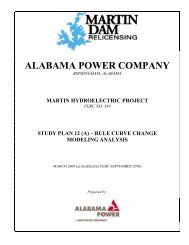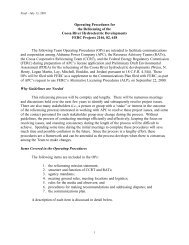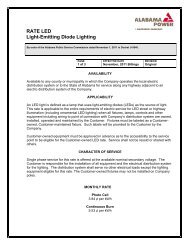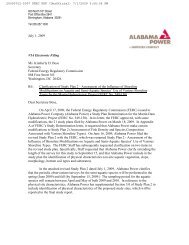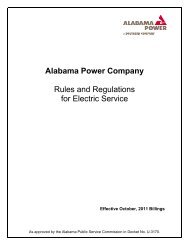Family - Alabama Power
Family - Alabama Power
Family - Alabama Power
Create successful ePaper yourself
Turn your PDF publications into a flip-book with our unique Google optimized e-Paper software.
Water Quality<br />
No matter what draws residents to the water –<br />
beauty, nature, tranquility or fun – water quality<br />
is crucial to their enjoyment. And just as diverse as<br />
these enticements of lake residency, the influencers<br />
of water quality are similarly varied and interlaced.<br />
Flood control and vegetation management help<br />
limit debris that causes navigation dangers on the<br />
water’s surface and displaces storage capacity by<br />
settling to the bottom. Shoreline protection – by<br />
maintaining its natural aspect – limits erosion and<br />
harmful runoff. And properly managed aquatic<br />
species and habitat help maintain the organisms<br />
that naturally benefit water quality.<br />
Because lakes are large bodies of slow-moving<br />
water, small changes in conditions can have<br />
broad-ranging impact. <strong>Alabama</strong> <strong>Power</strong> relies on<br />
relationships with water protection groups to help<br />
monitor and maintain the quality of the water that<br />
provides habitat for plants and animals and draws<br />
people to the state’s alluring lakes.<br />
— Brandon Glover, <strong>Alabama</strong> power<br />
Billy Brown<br />
Above: Vegetation management is important to the Tallapoosa<br />
river system. Right: Hydrilla can disrupt natural habitats when<br />
not managed.<br />
Billy Brown<br />
April Showers<br />
Determine the fate of summer lake levels<br />
This year’s extreme weather conditions<br />
continue to negatively impact <strong>Alabama</strong><br />
<strong>Power</strong> lakes. The rains normally seen in<br />
March and April never arrived, leaving<br />
many of the reservoirs unable to fill.<br />
State climatologist John Christy points to one<br />
possible cause of lagging rainfall. “La Niña winters,<br />
which have hit the Southeast region back to back,<br />
produce weather that is generally warmer and drier.<br />
This becomes especially problematic when it comes<br />
to conserving water resources.”<br />
With below-normal rainfall, all of <strong>Alabama</strong><br />
<strong>Power</strong>’s lakes on the Coosa and Tallapoosa rivers<br />
have experienced lower than normal pool levels.<br />
But the company has been proactive in the face of<br />
these dry conditions.<br />
<strong>Alabama</strong> <strong>Power</strong> began the spring by conserving<br />
water in its reservoirs by significantly reducing<br />
hydro generation to only those releases required by<br />
our federal licenses. The company requested – and<br />
received in mid-May – Federal Energy Regulatory<br />
Commission (FERC) approval for a reduction in<br />
minimum-flow requirements from Jordan Dam –<br />
allowing a 20 percent reduction in the navigation<br />
releases to the <strong>Alabama</strong> River.<br />
“These drought conditions have hit us hard this<br />
year, and at the worst time, when we normally fill<br />
Use your smart device to find:<br />
Weekly Drought updates<br />
for the state of <strong>Alabama</strong><br />
www.droughtmonitor.unl.edu/DM_<br />
the reservoirs to summer levels,” said Reservoir<br />
Management Supervisor Alan Peeples. “Our priority is<br />
to ensure, by working with federal and state agencies,<br />
we conserve water now for the coming months that will<br />
help preserve and protect, to the extent possible, the<br />
many and various needs placed on the reservoirs.”<br />
In anticipation of La Niña conditions, the company<br />
already received variances from the U.S. Army Corps<br />
of Engineers to fill Lake Harris, Weiss and Logan<br />
Martin earlier than normal this spring. FERC similarly<br />
approved a variance last fall to temporarily raise the<br />
Lake Martin winter pool level by 3 feet to boost the<br />
spring fill efforts.<br />
“We understand this is unpleasant news to the<br />
folks making plans to head out on our lakes with<br />
family and friends, but we do want them to be aware<br />
of what we all are dealing with,” said Peeples.<br />
The U.S. Drought Monitor updates state conditions<br />
weekly at www.droughtmonitor.unl.edu.<br />
For the latest on lake levels and <strong>Alabama</strong> <strong>Power</strong>’s<br />
efforts to manage these dry conditions, visit<br />
alabamapower.com and click the “Lake Conditions”<br />
link on the left side of the page. Information can also<br />
be obtained by calling <strong>Alabama</strong> <strong>Power</strong>’s automated<br />
Reservoir Information System at 1-800-LAKES11<br />
(1-800-525-3711).<br />
— keisa sharpe, alabama power<br />
Top: Lake Martin during winter pool. Bottom: Lake Martin flood<br />
gates open during flood conditions.<br />
10 state.htmAL,SE<br />
11<br />
William Dickey Marvin Gilmore



